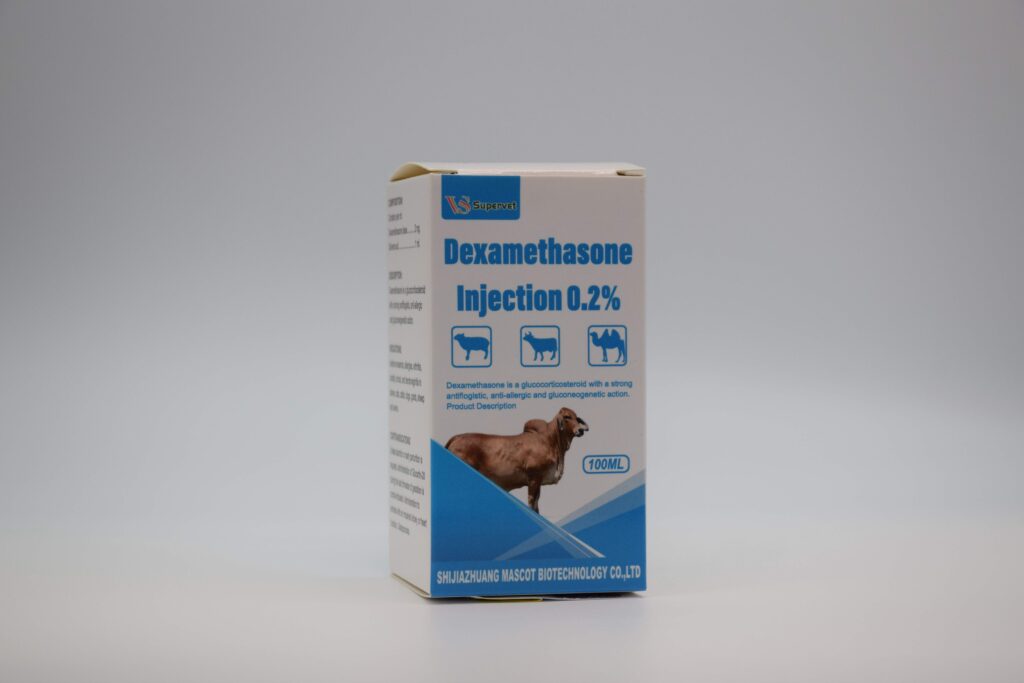
Dexamethasone Sodium Phosphate Injection
Name:
Dexamethasone Sodium Phosphate Injection
Common Capacity:
- Injection Solution: 10ml, 20ml, 50ml, 100ml/bottle (Referencing common capacities for similar veterinary dexamethasone products in the knowledge base, e.g., product containing “Dexamethasone” in )
Common Concentration:
- Injection Solution: Commonly 2mg/ml or 5mg/ml in veterinary preparations (actual concentration should be based on specific product labeling).
Applicable Animals:
This product is a synthetic adrenocorticosteroid with anti-inflammatory, anti-allergic, anti-shock, and immunosuppressive effects. Due to its broad and rapid action, it is suitable for a wide range of animal species.
- Monogastric Animals (Pigs):
- All stages of pigs: Used for the treatment of inflammation, allergic reactions, stress responses, various types of shock, and autoimmune diseases.
- Ruminant Animals (Cattle, Sheep):
- Cattle, Sheep: Used for the treatment of non-infectious inflammation (e.g., arthritis, tenosynovitis), allergic reactions (e.g., urticaria), ketosis, stress syndrome, and as an adjunctive treatment for periparturient paresis.
- Poultry (Chickens):
- Used for the treatment of stress responses, allergies, and certain inflammatory reactions.
- Pets (Dogs, Cats):
- Used for the treatment of allergic skin diseases, arthritis, asthma, autoimmune diseases, shock, and cerebral edema.
- Special Farming Animals:
- Such as rabbits, minks, etc., for the treatment of inflammation, allergies, and stress.
Usage and Dosage:
This product is mainly administered via intramuscular or intravenous injection. Specific dosage and duration of treatment should be determined based on the animal species, body weight, nature and severity of the disease, and veterinary diagnosis. Long-term use may lead to side effects.
Intramuscular or Intravenous Injection:
- Pigs, Cattle, Sheep:
- Anti-inflammatory, Anti-allergic: 0.02-0.05mg per kg body weight, once daily.
- Anti-shock, Ketosis treatment: 0.1-0.2mg per kg body weight, may be repeated as needed.
- Chickens:
- Anti-stress, Anti-inflammatory: 0.1-0.2mg per kg body weight, typically for individual treatment.
- Dogs, Cats:
- Dogs: 0.1-0.2mg per kg body weight, once daily, or adjusted according to the condition.
- Cats: 0.05-0.1mg per kg body weight, once daily, or adjusted according to the condition.
Dosage by Growth Stage:
- Neonatal Animals: Use with caution, especially avoid long-term use, as it may affect bone development and growth.
- Pregnant and Lactating Animals: Use with caution in late pregnancy, as it may induce premature birth or abortion. Use during lactation may affect milk quality.
Applicable Diseases and Symptoms:
This product is primarily used for the treatment of various inflammations, allergies, and stress responses, and as an auxiliary treatment.
- Inflammatory Diseases:
- Various non-infectious inflammations, such as arthritis, tenosynovitis, bursitis, myositis.
- Skin inflammations (e.g., eczema, dermatitis), ocular inflammations.
- Allergic Diseases:
- Anaphylactic shock, urticaria, serum sickness, allergic asthma, drug-induced dermatitis.
- Stress Syndrome:
- Loss of appetite, depression caused by transport stress, group transfer stress, sudden weather changes.
- Shock:
- Shock caused by various reasons, such as septic shock, hypovolemic shock, traumatic shock.
- Ketosis:
- Auxiliary treatment for postpartum ketosis in cattle and sheep.
- Others:
- Immunosuppressive treatment for certain autoimmune diseases.
- Adjunctive treatment for cerebral edema, spinal cord injury.
Precautions:
- Side Effects of Long-term Use: Long-term or high-dose use can cause significant side effects, such as water and electrolyte imbalances (water-sodium retention, increased potassium excretion), immunosuppression, gastrointestinal ulcers, muscle atrophy, osteoporosis, diabetes, adrenal cortical hypofunction. The principle of “replacement therapy” should be followed, with gradual dose reduction, and sudden discontinuation should be avoided.
- Use with Caution in Infected Animals: This product may mask the symptoms of infection and reduce the animal’s resistance. Therefore, use with caution in animals with bacterial, viral, or fungal infections, or must be used in combination with adequate antimicrobial drugs.
- Gastrointestinal Ulcers or Injuries: Use with caution in animals with a history of gastrointestinal ulcers or those prone to ulcers.
- Diabetes, Heart Disease, Nephritis, Glaucoma: Use with caution in animals with these conditions.
- Hepatic and Renal Impairment: Use with caution in animals with hepatic or renal impairment, as it may affect drug metabolism and excretion.
- Pregnant Animals: Use with caution in early pregnancy, especially in breeding females, as it may induce fetal malformations. High doses in late pregnancy can lead to abortion or premature birth.
- Vaccination Period: Immunosuppressive effects may reduce vaccine efficacy, so it is not recommended for use before or after vaccination.
- Withdrawal Period:
- Cattle, Sheep, Pigs: Meat: 28 days; Milk: 72 hours.
- Chickens: 28 days.
- (No withdrawal period requirements for pets)
Contraindications:
- Contraindicated in animals with severe bacterial, viral, or fungal infections that are not simultaneously treated with antimicrobial drugs.
- Contraindicated or use with extreme caution in animals with gastrointestinal ulcers, fractures, osteoporosis, diabetes, renal insufficiency, cardiac insufficiency, or glaucoma.
- Contraindicated in animals hypersensitive to corticosteroids.
Post-Administration Care:
- Monitor for Side Effects: During long-term administration, closely observe the animal for side effects such as polydipsia, polyuria, polyphagia, weight gain, lethargy, muscle atrophy, or worsening infection symptoms.
- Gradual Dose Reduction: Avoid sudden discontinuation of the drug; gradually reduce the dose as advised by the veterinarian to prevent adrenal cortical hypofunction.
- Enhanced Nutrition and Support: Animals on long-term medication should receive enhanced nutrition and supplementation with vitamins and minerals to prevent infections.
- Maintain Environmental Hygiene: Regularly clean and disinfect the animal’s living environment to reduce the risk of infection.
Applicable Animals
Animal species suitable for this veterinary medication


